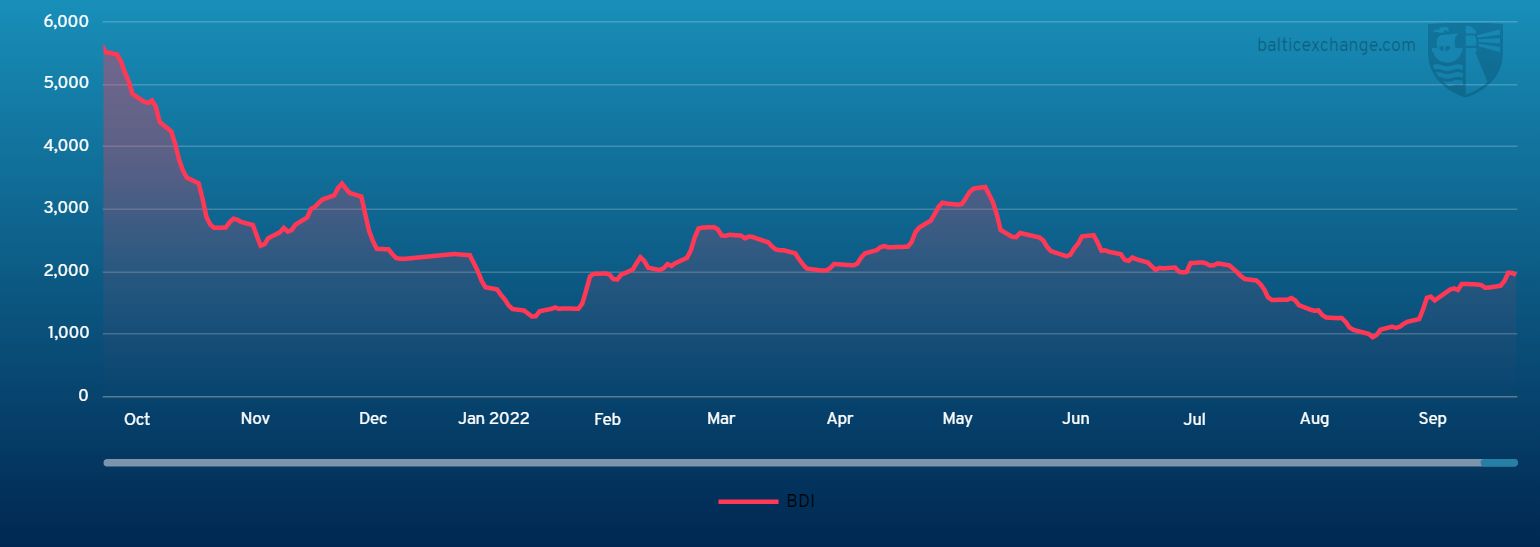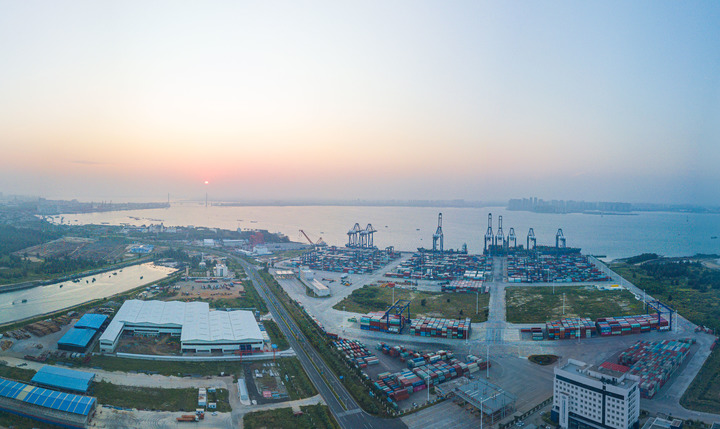BEIJING, Oct. 8 (Xinhua) -- The Baltic Exchange has published its weekly report of the dry and tanker markets for October 3-7, 2022 as below:
Capesize
The Capesize market inched higher this week as increased activity continues to lift expectations with the 5TC closing at $19,874, up 3,660 over the week. The Atlantic remains the more optimistic region. However, closing the week it looks like the Fronthaul routes may have become a little overheated as the C9 route lost $3,001 to settle at $39,813. Iron ore out of Brazil to the Far East is seeing the laycan on the C3 route split on loading dates. The C3 rose 0.128 on Friday to close at $24.667. In the Pacific, there were only a couple of major charterers around looking for tonnage to end the week, as such rates remained relatively steady. The West Australia to Qingdao C5 route closed at $9.06 while the Transpacific C10 dropped $455 to close out at $12,636. Backhaul has been an interesting route to watch this week as several coal cargoes out of Australia heading to Europe have pushed the C16 up to healthy levels. The route now at $6,611 is a far cry from the aggressive negative rates that were witnessed several weeks ago. Owners will now have an eye on when the next voyage will end as time ticks down to the end of this quarter and the beginning of the historically seasonal lows of Q1.
Panamax
After a muted opening, the Panamax Atlantic market rallied mid week. With golden week - and other Asian holidays - it returned a mostly inactive week. However, come Thursday some life was visible in the Asian market, predominantly NoPac centric with a host of deals concluded at rates better than last done. Back to the Atlantic and several deals concluded in excess of $31,000 on fronthaul trips basis delivery this side, as tonnage tightness from the the Continent and Mediterranean combined with strong demand led to a firmer market. Limited activity from Indonesia this week with holidays impacting, but rates rose slightly as the week ended. NoPac saw a mixture of rates over the course of the week, ranging from low $16,000s with the high at $20,000. However, the mean average returned around the $18,000 mark throughout the week. A flurry of FFA activity lent some support mid week to some period appetite, with several deals concluded.
Ultramax/Supramax
With the widespread holidays during the week, action mainly centred around the Atlantic basin. As the Asian arena lacked fresh impetus generally, the area remained relatively steady with many players happy to wait until the holidays finished. Period activity was seen with a 58,000dwt open Indonesia fixing for six to eight months trading at $19,000. The Atlantic saw increased activity for many areas. The US Gulf bounced back after a recent lull, with ultramax size now seeing in the upper $20,000s for trips to Singapore-Japan. Similarly, stronger rates from South America. A 63,000dwt fixing close to $20,000 plus $1 million ballast bonus for trip to the Arabian Gulf. From Asia, a slight easing in rates. A 61,000dwt open Cebu was fixed for a trip Via Indonesia to China at around $21,000. Meanwhile, from the north, a 63,000dwt with delivery North China fixed a trip to West Coast India at $18,000. With eyes fixed on the upcoming week, the BSI closed at 1,706 with the 10 TC weighted average now standing at $18,763.
Handysize
A split week with sentiment remaining positive in the Atlantic, whilst from Asia positive sentiment remained in short supply. Period activity surfaced and a 37,000dwt opening China fixing at 108 percent of BHSI for 11 to 13 months trading. Rates remained strong in many regions of the Atlantic. From South America a 41,000dwt was heard fixed for a coastal run in the mid $30,000s, whilst from North Coast South America a 37,000dwt fixed in the upper $20,000s for a trip to Norway. Elsewhere activity from the Mediterranean saw a 35,000dwt fixing a trip delivery East Mediterranean via the Black Sea (excluding Russia/Ukraine) redelivery USA in the high teens. With the holidays in Asia, rates lowered. A 28,000dwt open China’s Hong Kong was heard fixed for an Australian round at around $14,500. BSHI finished proceedings at 1,033 and the 7TC weighted average now standing at $18,588.
Clean
In the Middle East Gulf this week most LR runs have seen more declines from inactivity. TC1 lost 15.62 points to WS169.38. Similarly, on the LR1s, TC5 ended up at WS171.43 (-19.28) with a trip west and TC8 declined from around $3.4m to $3.25m. There are reports of multiple TC5 fixtures at WS170 on subjects at the time of writing, which may suggest the market has levelled off for the moment. On the MRs TC17 improved this week and the index has been pushed up from WS260 to WS284.58.
West of Suez LR2s have been subject to minimal open enquiry again. TC15 softening has continued and the index dropped from $4.05m to $3.65m. We have seen increased demand down to West Africa on the LR sector this week. TC16 has subsequently seen an improvement and come up 12.14 points to WS231.43.
On the UK-Continent MRs, after a nearly two week continuous decline, has been relatively stable this week with TC2 hovering around the Mid WS250s. Likewise, TC19 has been floating around the high WS250s – low WS260s.
In the US Gulf, activity has continued to dwindle this week for the MRs - coupled with a tonnage supply increasing in availability - freight rates have taken a tumble. TC14 and TC18 have both lost over 100 points to end up at WS185.83 and WS282.5 respectively. Also a run down the Caribbean TC21 has lost nearly 50 percent of its value from $1,645,000 to $830,000.
The MR Atlantic Triangulation Basket TCE lost $17,720 from $49,825 to $32,105.
On the Handymax, in the Mediterranean TC6 looks to have reached a plateau at the WS317.5 - 320 mark this week from a good supply to demand balance. In the Baltic, TC9 has continued a steady tick upwards rising 22.15 points to WS382.5.
VLCC
VLCC rates dipped this week, in the most part due to the Golden Week and associated holidays in the Far East, which has kept the market very quiet. For the 270,000mt Middle East Gulf/China voyage rates fell almost six points due to the silence from the Korean and Chinese players. However, at the time of writing the market is bouncing back, rising almost three points, according to our panelists yesterday, to very nearly WS81 (a round trip TCE of $41,700 per day). The rate for 280,000mt Middle East Gulf/USG (via Cape of Good Hope) is assessed about one point less than a week ago at WS46.5-47 level.
In the Atlantic, rates for 260,000mt West Africa/China fell two points to just above WS83 ($45,200 per day round-trip TCE). For the 270,000mt US Gulf/China market, rates recovered by $387,500 to a little over $9,930,000 (showing a round trip TCE of $40,600 per day).
Suezmax
Rates for 135,000mt Black Sea/Augusta dropped another five points this week to WS175 (a round-trip TCE of $69,800 per day), while for the 130,000mt Nigeria/UKC trip rates also slipped five points to a shade below WS125 (a round-trip TCE of $34,600 per day). In the Middle East the rate for 140,000mt Basrah/West Mediterranean eased two points to WS64.
Aframax
Rates in the Mediterranean market gained more ground this week with the rate for 80,000mt Ceyhan/West Mediterranean improving another nine points to almost WS222 (a round-trip TCE of $61,400 per day). In Northern Europe, rates carried on their upward trajectory with the latest assessment for 80,000mt Hound Point/UK Continent seven points firmer than a week ago at WS200 (a daily round-trip TCE of $64,700 per day). For the 100,000mt Primorsk/UK Cont route the rate is assessed 3.5 points stronger at WS223 (a round trip TCE of $73,300 per day).
Across the Atlantic, the market lost further value with the rate for 70,000mt EC Mexico/US Gulf falling another 16 points to just under WS200 (a round-trip TCE of $34,500 per day), while the rate for the 70,000mt Caribbean/US Gulf trip lost 15 points to WS190 (a daily round-trip TCE of about $29,700). For the transatlantic route of 70,000mt US Gulf/UK Continent, the rate shed a further 2.5 points to WS208.5 (showing a $37,300 per day round-tip TCE).
Headquartered in London and a subsidiary of the Singapore Exchange (SGX), the Baltic Exchange publishes a range of indices and assessments which provide an accurate and independent benchmark of the cost of transporting commodities and goods by sea. These include the Baltic Dry Index (BDI), the dry bulk shipping industry's best known indicator. Published daily since 1985, this provides a snapshot of the daily spot market earnings of capesize, panamax and supramax vessel types on the world's key trading routes.

Chart shows Baltic Dry Index (BDI) during Oct. 8, 2021 to Oct.7, 2022

Baltic Forward Assessment for BDI
In March 2018 the BDI was re-weighted and is published using the following ratios of time charter assessments: 40 percent capesize, 30 percent panamax and 30 percent supramax. The information is provided by a panel of international shipbrokers.
(Source: The Baltic Exchange, edited by Niu Huizhe with Xinhua Silk Road, niuhuizhe@xinhua.org)




 A single purchase
A single purchase









